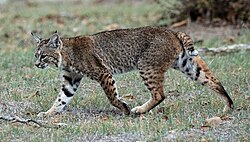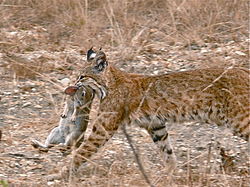Bobcat
The bobcat (Lynx rufus) is a fierce cat that lives in forests, swamps, mountains, prairie, and deserts in many parts of North America. Bobcats are generally nocturnal (active at night), but can be seen at dawn and dusk. They spend the day in their den (a cave, hollow log or rock crevice). They are very good climbers and swimmers. Bobcats’ lifespan in the wild varies from 5 to 15 years. In captivity, they can live up to 18 years. Bobcats and lynxes are closely related.
| Bobcat | |
|---|---|

| |
| Bobcat in Livermore, California, USA | |
| Conservation status | |
| Scientific classification | |
| Kingdom: | Animalia |
| Phylum: | Chordata |
| Order: | Carnivora |
| Family: | Felidae |
| Genus: | Lynx |
| Species: | L. rufus
|
| Binomial name | |
| Lynx rufus (Schreber, 1777)
| |

| |
| Distribution of Bobcat, 2016[1] | |
| Synonyms | |
| |
Description
The Bobcat has powerful jaws and long, pointed canine teeth. It has sharp, retractable claws, big short ears, and a spotted coat. Many bobcats have long tufts of hair at the tip of the ears that improve the cat's hearing. The brown eyes have round pupils. These graceful cats are from 24 to 40 inches (60–100 cm) long (including the tail). The stubby tail is only 4 to 7 inches (10–18 cm) long, and looks as though it was cut off (or bobbed). This is what this cat is named for. They are nocturnal (that means active at night) and elusive so they are rarely seen by humans.
Diet
Bobcats are carnivores (meat-eaters). These fast, solitary hunters eat small mammals (like rabbits, rodents, weasels and even deer), birds, and ducks, turkeys. Bobcats stalk their prey, and then pounce onto it. They can leap up to 10 feet (3 m). They can often kill their prey with one very powerful bite.
Bobcat Media
The Canada lynx has distinct tufts atop its ears and longer "mutton chop" style fur on its lower face
Bobcat in urban surroundings, seen here climbing on a telegraph pole at the Kennedy Space Center. The species' range does not seem to be limited by human populations, as long as it can still find a suitable habitat.
Bobcat spotted in South San Jose, California
References
- ↑ 1.0 1.1 Kelly, M.; Morin, D. & Lopez-Gonzalez, C. A. (2016). "Lynx rufus". IUCN Red List of Threatened Species. IUCN. 2016: e.T12521A50655874.
| Wikispecies has information on: Lynx rufus. |









